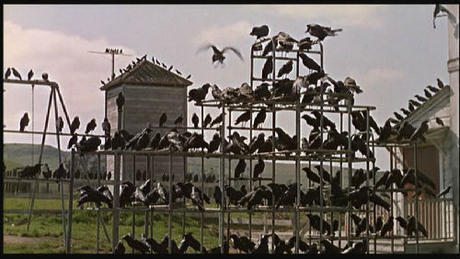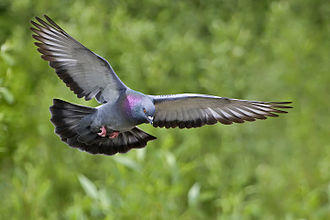The hologram is a spectacular invention of the modern era: an innocuous artefact that can miraculously generate three-dimensional imagery. Yet this modern experience has deep roots. Holograms are part of a long lineage: the ability to generate visual “shock and awe” has, in fact, been an important feature of new optical technologies over the past century and a half.
The post Holograms and the technological sublime appeared first on OUPblog.
By Siu-Lan Tan
Films trick our senses in many ways. Most fundamentally, there’s the illusion of motion as “moving pictures” don’t really move at all. Static images shown at a rate of 24 frames per second can give the semblance of motion. Slower frame rates tend to make movements appear choppy or jittery. But film advancing at about 24 frames per second gives us a sufficient impression of fluid motion.
However, birds–such as pigeons–have a much higher threshold for detecting movement. A bird’s visual system is keenly sensitive to moving stimuli as this is essential to their survival. Whether swooping down to snatch live prey, fleeing from a predator, or zeroing in on a nest for a precise landing, birds must rely on their fine-tuned ability to hone in on moving targets. So the frame rate at which most of our films are shown is far too slow for birds to perceive continuous motion. Their threshold of visual processing exceeds the standard frame rate, allowing them to see component frames … and the illusion of motion pictures would be broken.
If a pigeon had been roosting in the theater where 19th century crowds first gaped at the Lumière Brothers’ steam train looming towards them, it may have been less than impressed — especially as early silent films were often played at only 16 frames per second.
Click here to view the embedded video.
Even a film shown at today’s industry standard of 24 frames per second would most likely look like a series of flashing slides to a pigeon. We’re mesmerized by Marilyn Monroe’s white skirts billowing over the subway grate in The Seven-Year Itch, but a pigeon may see something more like a slide show of the skirt in frozen increments.
Further, most humans cannot distinguish individual lights flashed at 60 cycles per second, perceiving instead a single continuous beam of light. This gives an impression of constant light while watching a film (despite the shutter actually shutting out light several times per frame). But birds have much higher critical flicker-fusion frequency, such as 90-100 cycles per second or higher (e.g., Lisney et al., 2011). So while humans do not perceive the flicker in a movie, a pigeon may see flashes like strobelights along with the jumpy frames of Marilyn’s airborne skirt.
One of the creepiest scenes in Hitchcock’s The Birds shows Melanie (Tippi Hedren) smoking on a bench in a school playground while birds are flocking on a jungle gym behind her. She finally spots a lone bird flying overhead and turns around to discover every rung of the jungle gym crowded with large black birds. Actually, Hitchcock used cardboard cut-outs for most of the “birds” on the jungle gym, figuring that most people would not notice these stationary objects if interspersed with live birds.

Birds in a school playground in Hitchcock’s (1964) The Birds
Indeed, the illusion works on most of us. We are also often tricked by illusory “crowds” in films–made of real people and dummies, or multiple images of the same people patched together to make a “crowd”. However birds are especially observant of the movement of other birds–and combined with the much faster ‘refresh rate’ of the avian visual system (as their visual information is “updated” more frequently than humans)–the jungle gym scene would not likely fool any birds.
Studies suggest that birds do perceive some information via video images (using video at 30 frames per second). For instance, a video of wild chickens feeding elicits feeding in birds of the same species (McQuoid & Galef, 1993); videos showing a hawk or raccoon elicit aerial and ground alarm calls respectively in roosters (Evans, Evans, and Marler, 1993); and video images of female pigeons elicit courtship displays in male pigeons (Shimizu, 1998).
So birds seem to pick up some information from video images, at a somewhat higher frame rate and screen-refresh rate than film–though color may be distorted (Wright & Cumming, 1971), and gaps in movement and flicker are likely perceived (Lea & Dittrich, 1999). These discrepancies would be much more pronounced for moving images on cinematic film.
A fine-tuned visual system gives birds of prey an advantage when pursuing a fast-moving target. And it allows pigeons those few extra seconds to peck at grubs and seeds–and flap away at the last moment possible when your car approaches.
Nut their super-efficient processing of moving stimuli would make the cinematic experience as we know it less than spellbinding for the birds.
In conclusion: it’s interesting to note that film relies on certain limitations or imperfections of the human perceptual system for its magic to work!
Siu-Lan Tan is Associate Professor of Psychology at Kalamazoo College in Michigan, USA. She is primary editor of The Psychology of Music in Multimedia (Oxford University Press 2013), the first book consolidating the research on the role of music in film, television, video games, and computers. A version of this article also appears on Psychology Today. Siu-Lan Tan also has her own blog, What Shapes Film? Read her previous blog posts.
Subscribe to the OUPblog via email or RSS.
Subscribe to only psychology articles on the OUPblog via email or RSS.
The post Why you can’t take a pigeon to the movies appeared first on OUPblog.





